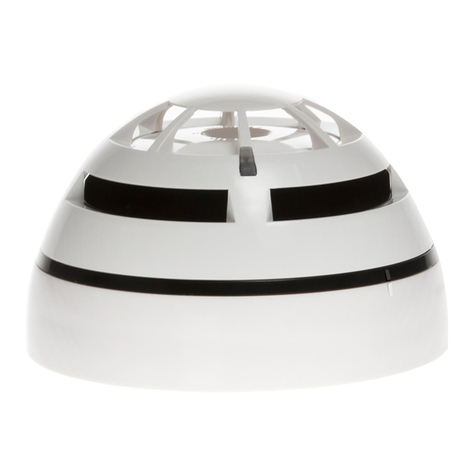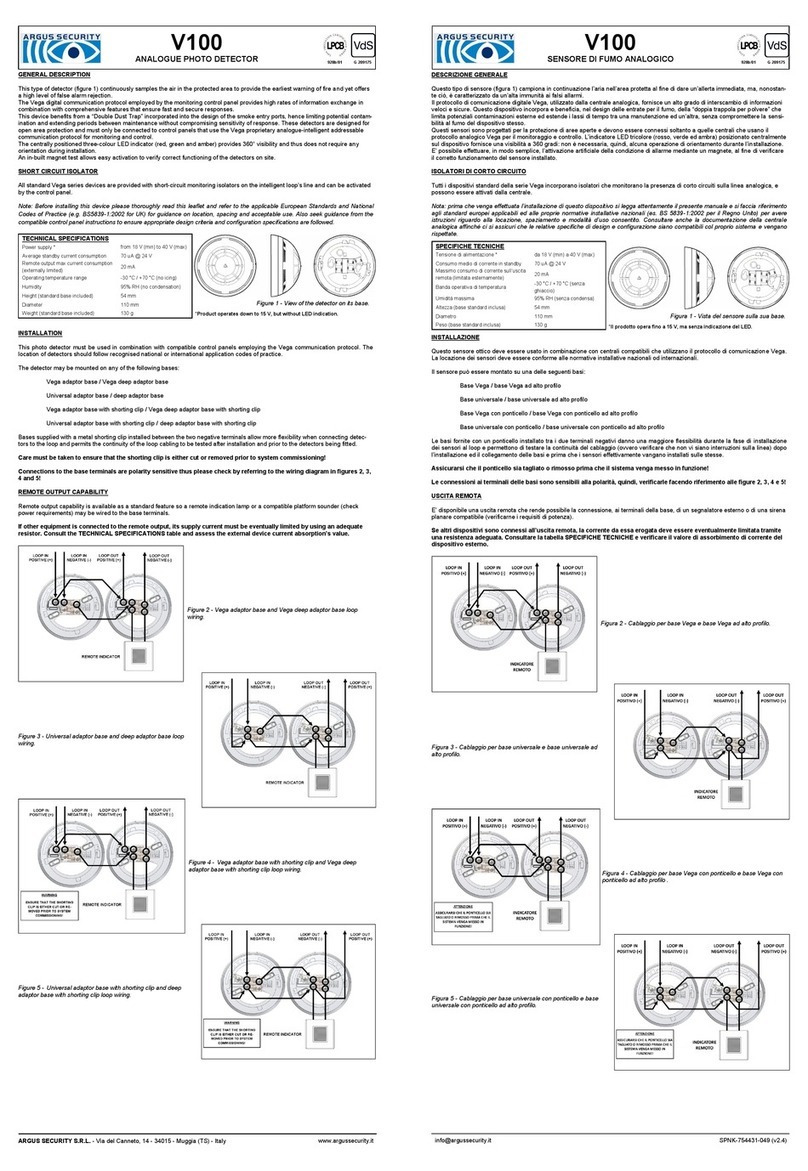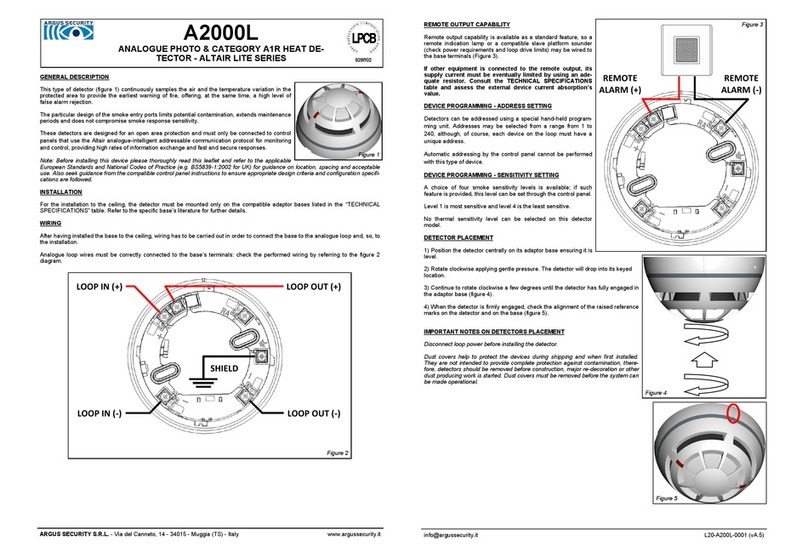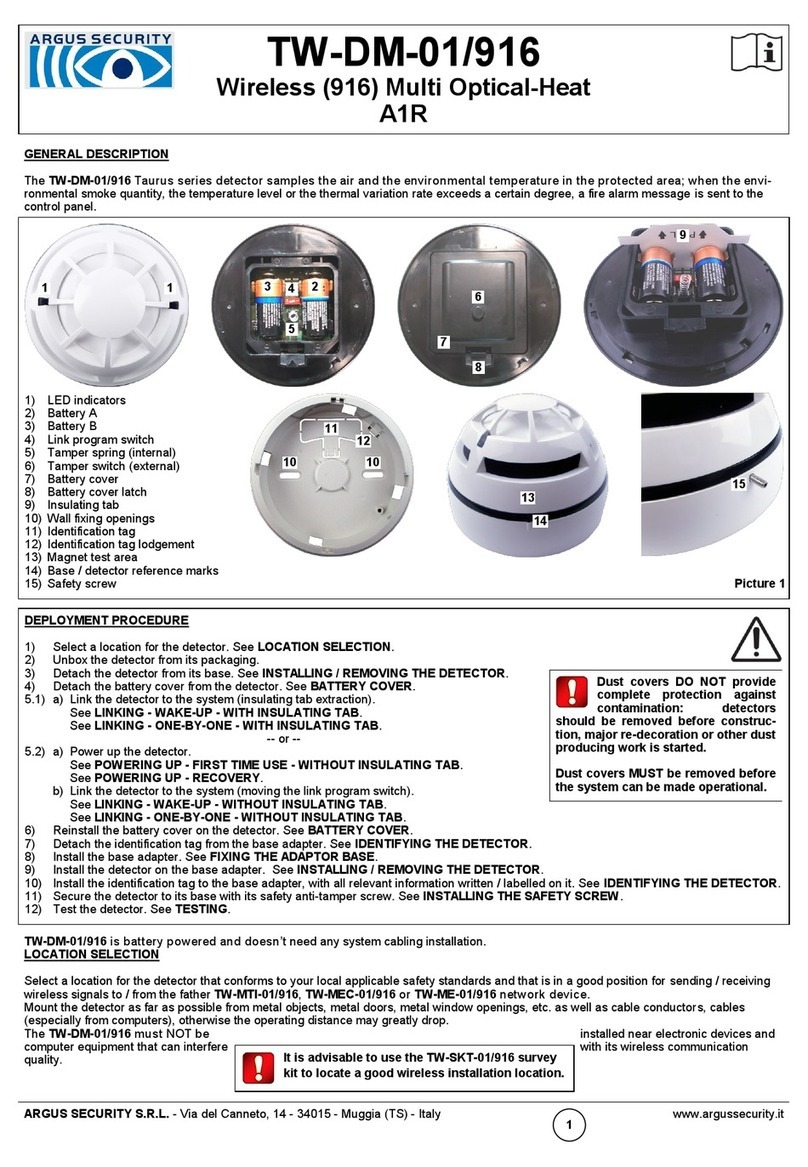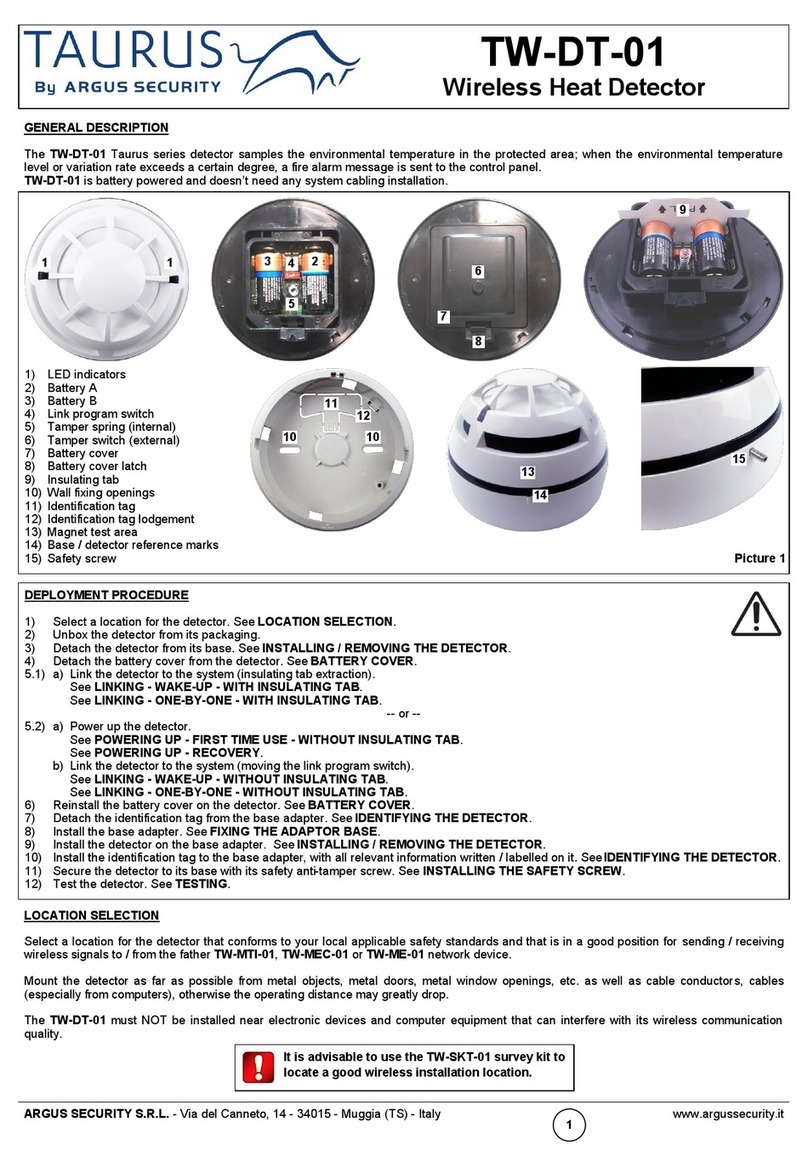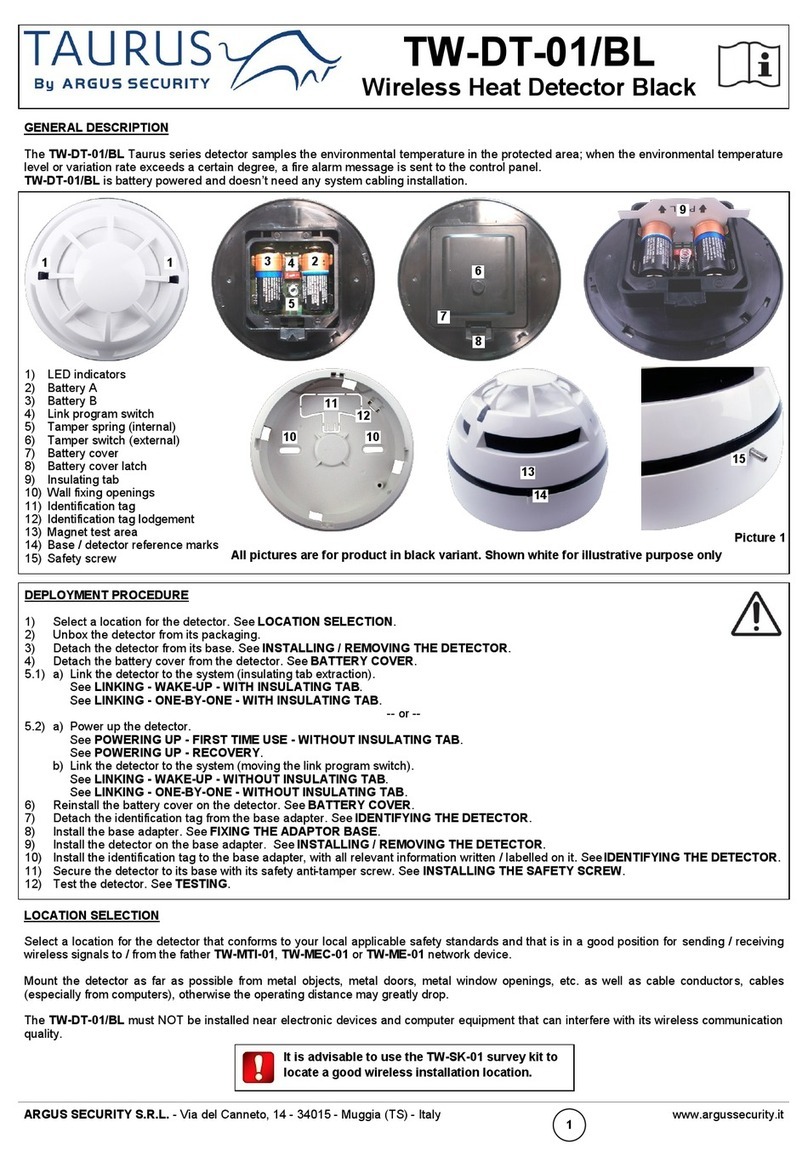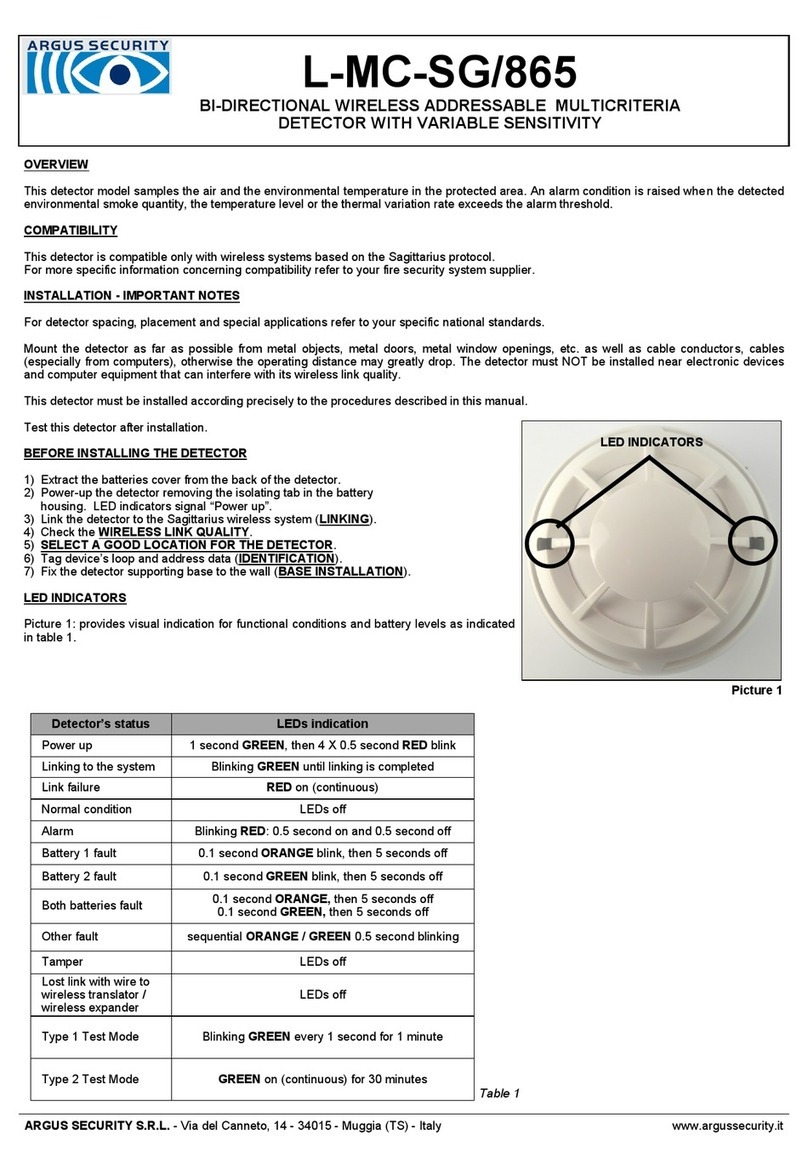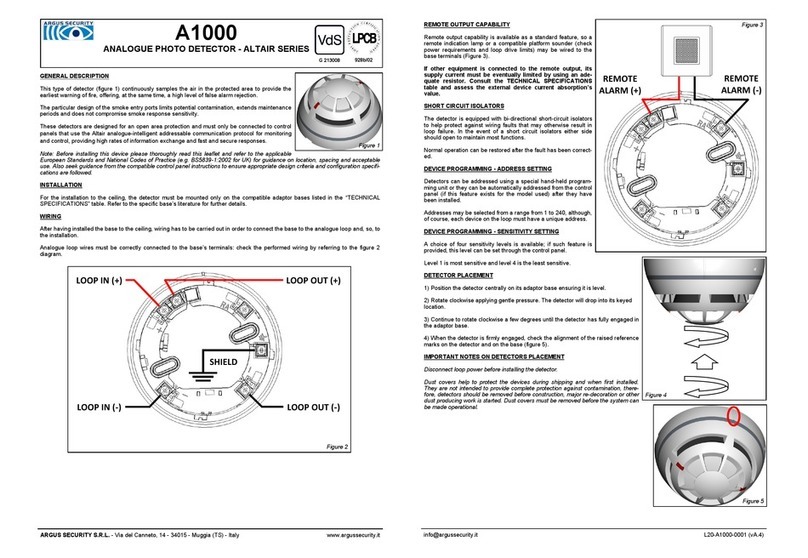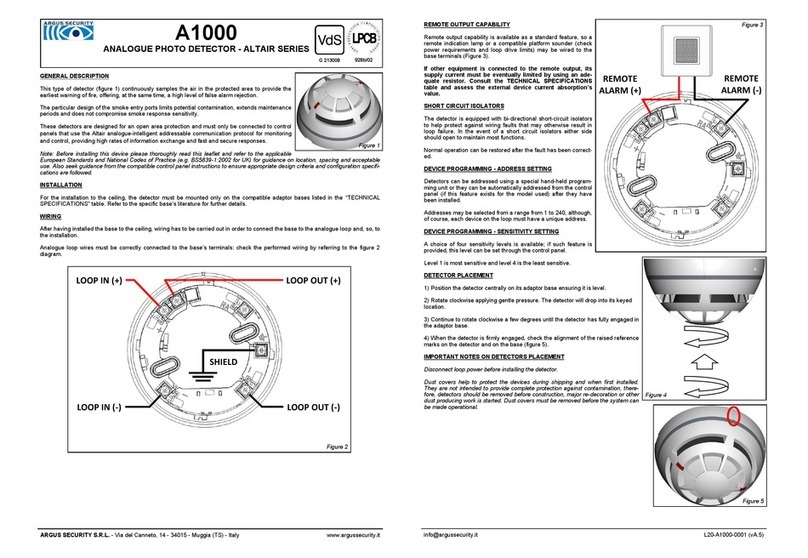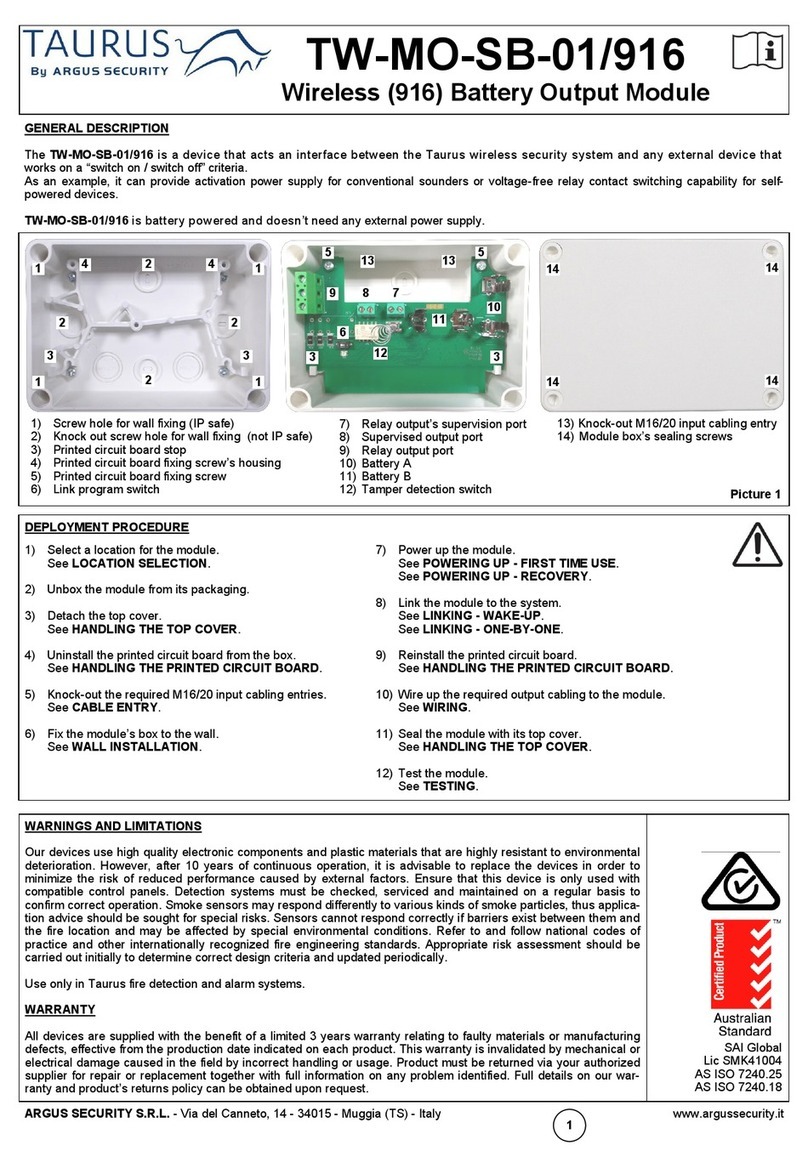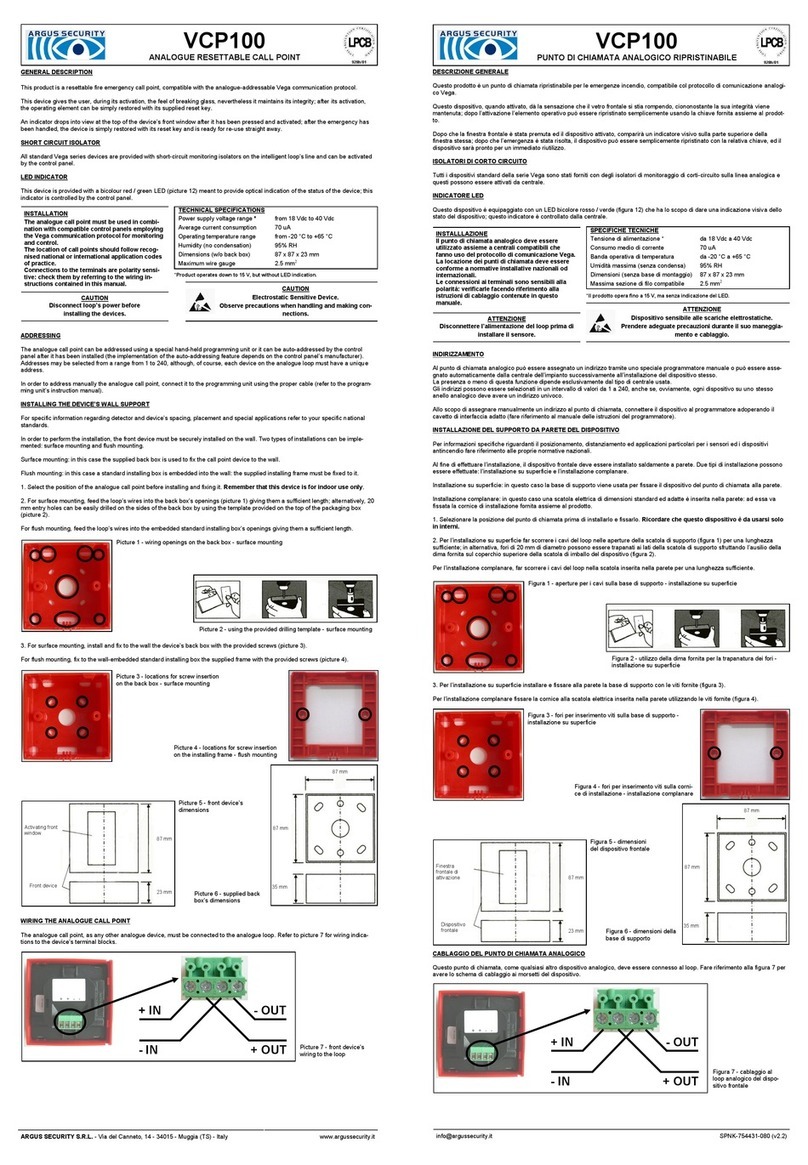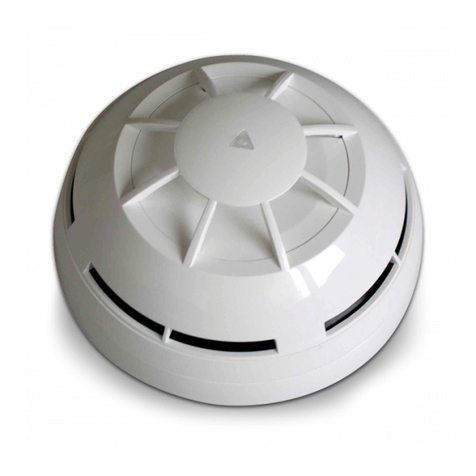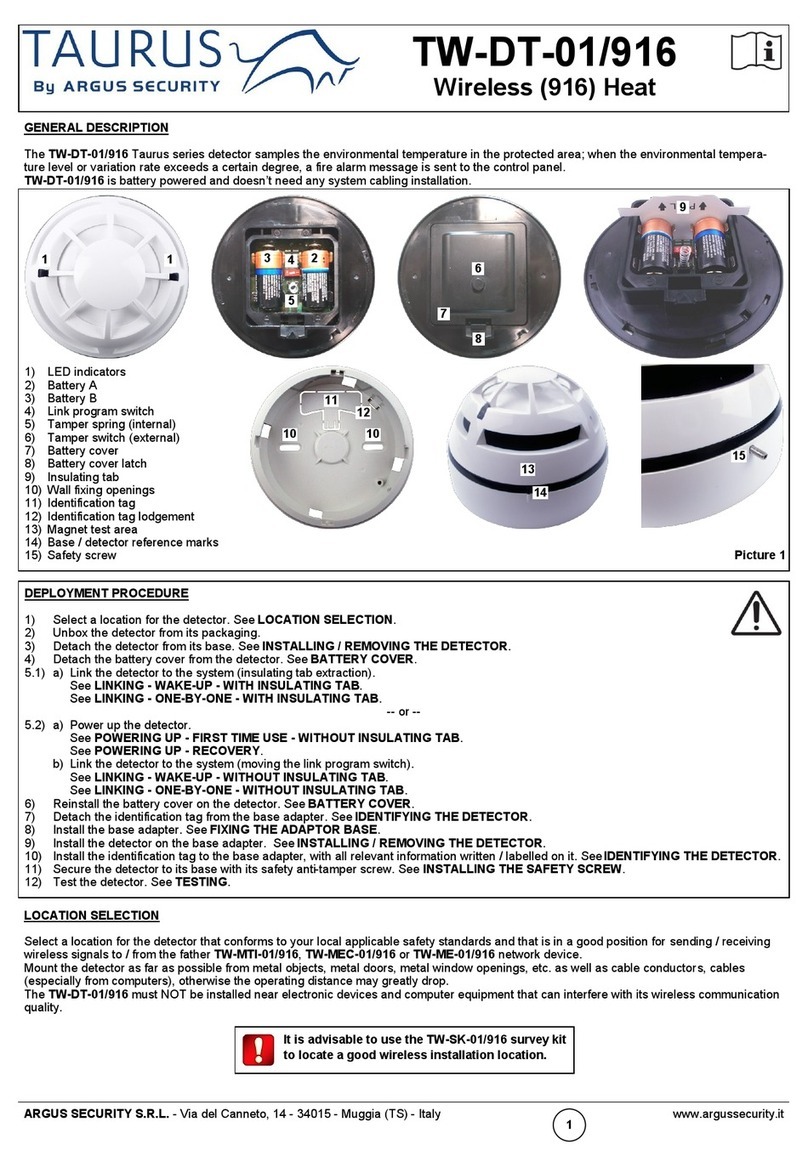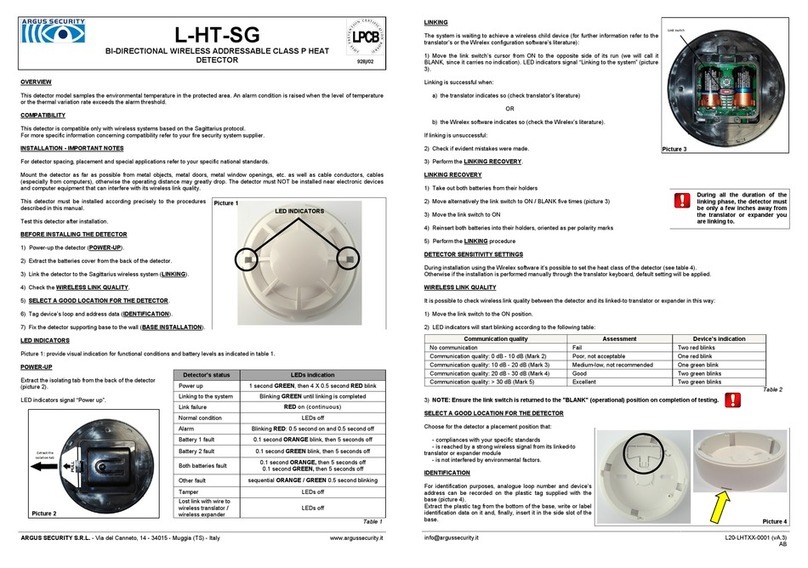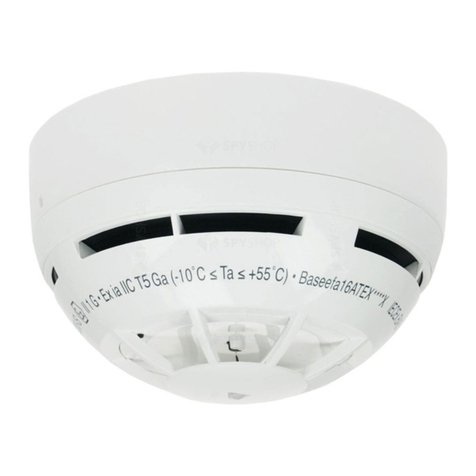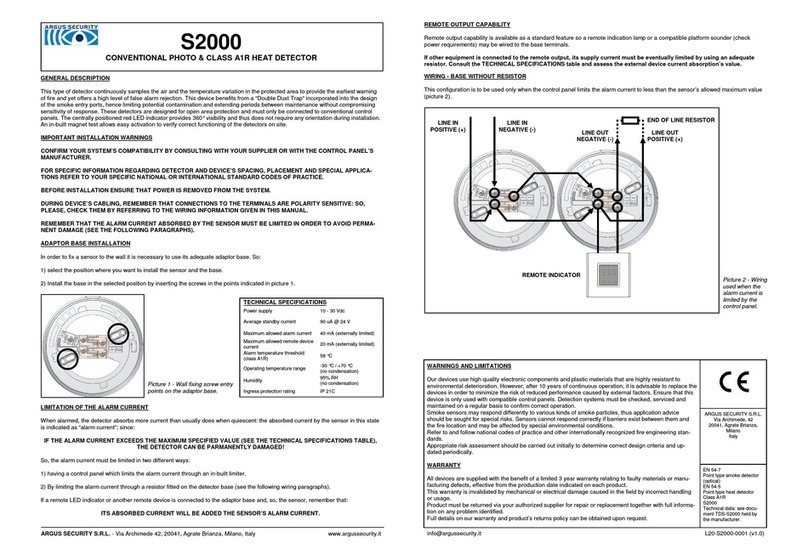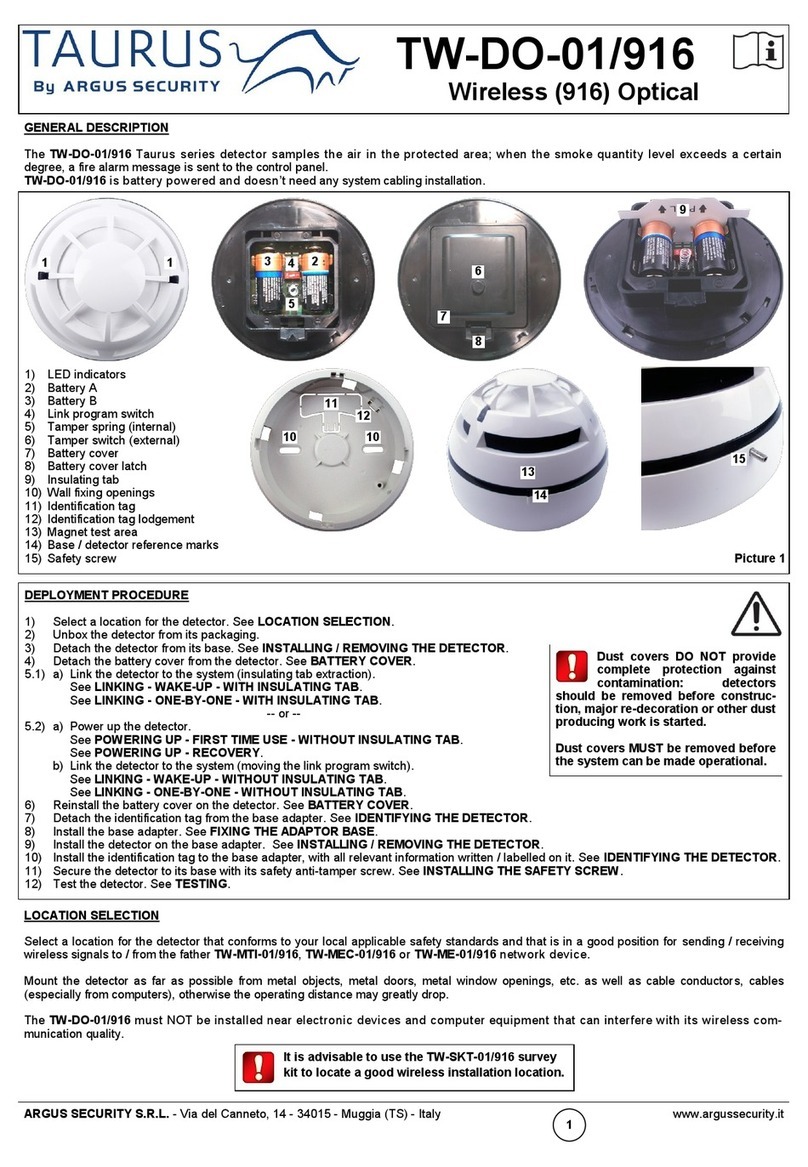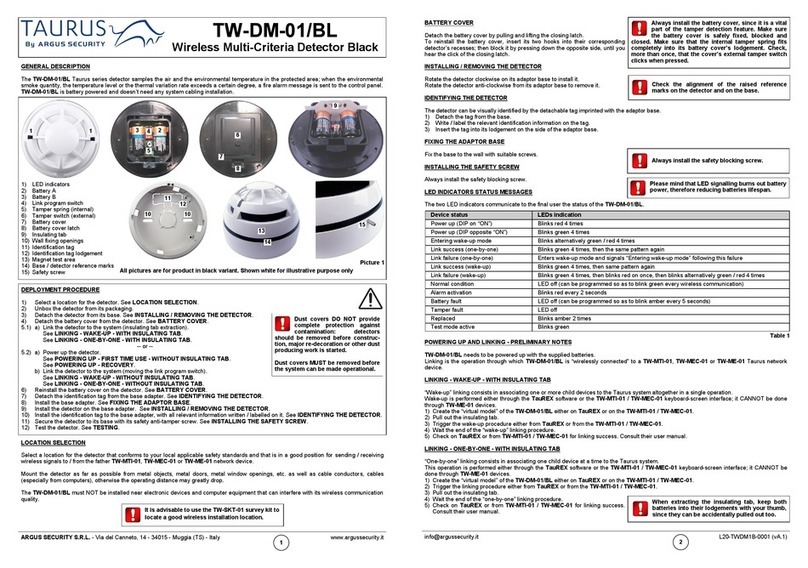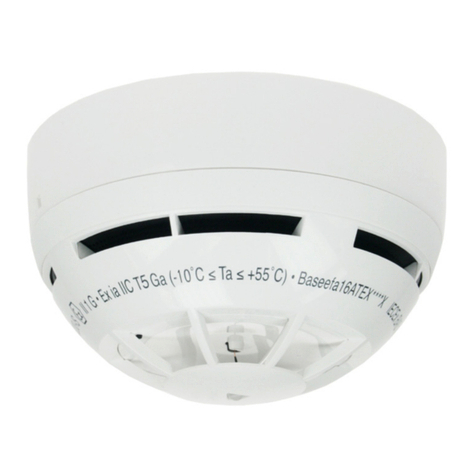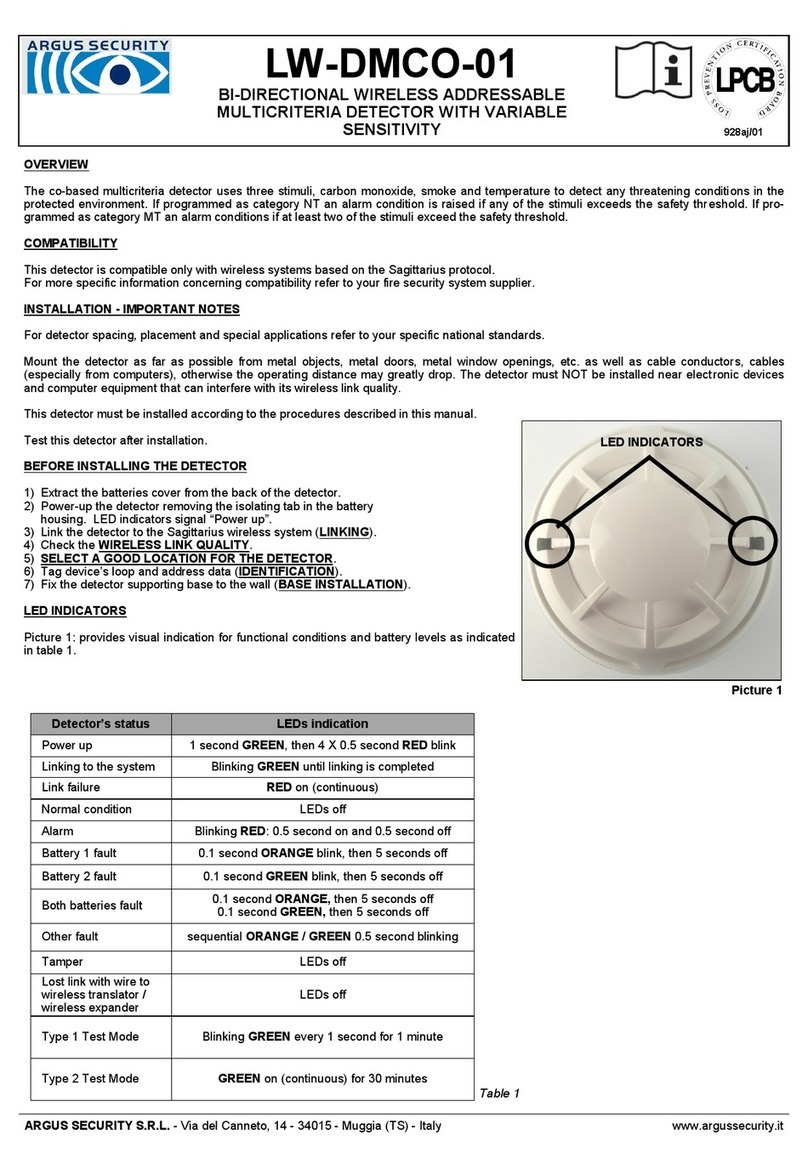BASE INSTALLATION
Fix the base to the wall with the provided screws (picture 4).
DETECTOR PLACEMENT
1) Install the batteries cover.
2) Position the detector centrally on the base
ensuring it is level.
3) Rotate clockwise applying gentle pressure.
The detector will drop into its keyed location.
4) Continue to rotate clockwise a few degrees
until the detector has fully engaged in the
base.
5) When the detector is firmly engaged, check
the alignment of the raised reference marks
on the detector and on the base (picture 5).
DETECTOR LOCKING
To lock the detector to the base, screw in the provided security screw; screw entry is locat-
ed on the side of the detector’s base (picture 6).
TAMPER DETECTION
When the detector is detached from the base a tamper message event is sent to the control panel.
TESTING
Test this detector after installation.
After each test reset the fire security system from the control panel, as per your control panel in-
structions.
TEST MODES
Test modes make the L-MC-SG more reactive to aerosol stimulus; two test mode types are
provided:
Type 1 Test Mode - triggered by a test magnet; persists for 1 minute. This mode makes the detector
almost instantaneously alarm agent reactive.
Type 2 Test Mode - remotely triggered by the Wirelex program; persist for 30 minutes. This mode
makes the detector as reactive to smoke as an optical smoke detector, simulating it.
TEST 1 - MAGNET TEST
1) Hold a suitable magnet in correspondence of the indicated area (picture 7)
2) LED indicator will signal “Type 1 Test Mode”
3) Apply again the magnet in correspondence of the indicated area (picture 7)
4) LED indicator will signal “Alarm”
TEST 2 - AEROSOL TEST
Use only suitable aerosol testers supplied by approved manufacturers.
1) Hold a suitable magnet in correspondence of the indicated area (picture 7)
2) LED indicator will signal “Type 1 Test Mode”
3) By following its specific instructions, apply the aerosol test device to the detector
4) Wait a few seconds
5) LED indicator will signal “Alarm”
TEST 3 - AEROSOL TEST
Use only suitable aerosol testers supplied by approved manufacturers.
1) Remotely activate the detector’s green LED from the Wirelex program
2) LED indicator will signal “Type 2 Test Mode”
3) By following its specific instructions, apply the aerosol test device to the detector
4) Wait a few seconds
5) LED indicator will signal “Alarm”
TEST 4 - HEAT TEST
Use only suitable heat test devices from approved manufacturers.
1) By following its specific instructions, apply the heat test device to the detector.
2) Wait a few seconds.
3) LED indicator will signal “Alarm”.
Picture 5
Dust covers DO NOT provide
complete protection against
contamination: detectors
should be removed before construc-
tion, major re-decoration or other dust
producing work is started.
Dust covers MUST be removed before
the system can be made operational.
ARGUS SECURITY S.R.L. - Via del Canneto, 14 - 34015 - Muggia (TS) - Italy www.argussecurity.it
Picture 4
Picture 6
Picture 7
MAINTENANCE - CLEANING
1) Remove the detector from its base.
2) Smoke entry areas and thermistor area: use a small,
soft bristle brush to dislodge any obvious contaminants
such as insects, spider webs, hairs, etc.
3) Smoke entry areas and thermistor area: use a small
vacuum tube or dry, clean, compressed air to suck up or
blow any remaining small particles away.
4) Wipe the exterior housing of the detector with a clean,
damp, lint-free cloth to remove any surface film that can
later attract airborne contaminants.
5) Install the detector onto its base again.
6) Test the detector.
MAINTENANCE - BATTERY REPLACEMENT
When a low battery condition is indicated,
both batteries must be changed altogether.
During this procedure the linking switch must NOT
be touched at all !
1) Detach the detector from its base.
2) Extract the batteries cover.
3) Extract the batteries.
4) Insert the new batteries into their holders,
oriented as per polarity marks.
5) Reinstall the batteries cover.
6) Reinstall the detector onto its base.
7) Test the detector.
AB
Table 3
TECHNICAL SPECIFICATIONS **
Communication range with the
translator or expander 200 m Open space
Operating frequency 868 MHz
Operating frequency channels 7
Radiated power ≤ 14 dBm (25 mW)
Batteries type* Type CR123A (3 Vdc) 8.2 years life
Parent expander’s check-up period 60 seconds (default setting)
Alarm threshold temperature.
Class A1R ROR 58 °C
Alarm threshold temperature.
Class B - high temperature 78 °C
Dimensions 110 mm x 65 mm
Weight 190 g Base and batteries
included
IP rating 40
Max tolerated humidity
(no condensing) 95% RH
Operating temperature range From –10 °C to +55 °C
WARNINGS AND LIMITATIONS
Our devices use high quality electronic components and plastic materials that are highly resistant to environ-
mental deterioration. However, after 10 years of continuous operation, it is advisable to replace the devices in
order to minimize the risk of reduced performance caused by external factors. Ensure that this device is only
used with compatible control panels. Detection systems must be checked, serviced and maintained on a regular
basis to confirm correct operation. Smoke detectors may respond differently to various kinds of smoke particles,
thus application advice should be sought for special risks. Detectors cannot respond correctly if barriers exist
between them and the fire location and may be affected by special environmental conditions. Refer to and follow
national codes of practice and other internationally recognized fire engineering standards. Appropriate risk
assessment should be carried out initially to determine correct design criteria and updated periodically.
WARRANTY
All devices are supplied with the benefit of a limited 3 year warranty relating to faulty materials or manufacturing
defects, effective from the production date indicated on each product. This warranty is invalidated by mechani-
cal or electrical damage caused in the field by incorrect handling or usage. Product must be returned via your
authorized supplier for repair or replacement together with full information on any problem identified. Full details
on our warranty and product’s returns policy can be obtained upon request.
ARGUS SECURITY S.R.L.
Via del Canneto, 14
34015 Muggia (TS)
Italy
16
LI0110CPR
EN 54-25:2008
EN 54-5:2000
Class A1R
EN 54-7:2000+A1:2002+A2:2006
CEA 4021:2003
L-MC-SG
For use in compatible fire
detection and alarm system
SMOKE SENSITIVITY (EN 54)
Threshold level Wirelex setting Notes
Level 1 High
Level 2 Normal default
Level 3 Low
THERMAL SENSITIVITY (EN 54)
Detector Class Wirelex setting Notes
A1R A1R default
BS High temperature Non-approved
NOTE OF THE DOCUMENT:
Argus Security Srl hereby declares that this detector is in compliance with the essential requirements and
other relevant provisions of Directive 1999/5/EC. A copy of the original Declaration of Conformity
(Document: DoC LI01) is made available to the user on website: www.argussecurity.it
Table 4
Table 5
* When a low battery condition is indicated, both batteries must be changed for new cells.
Lifespan of batteries indicated is subject to standard environmental conditions default
monitor settings and excellent link quality.
** Check latest version of document TDS-LMCXX for further data, obtainable from your
supplier.
